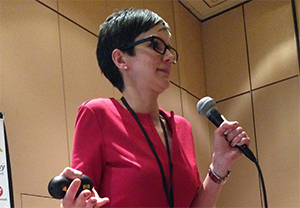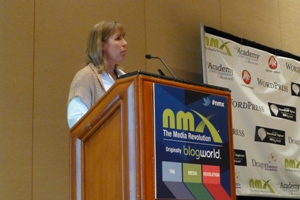|
Guide to Surviving the Zombie Content Apocalypse #NMX
 | Uh oh. The apocalypse is coming. It’s like impending doom, lurking closer and closer, threatening to take us down. What’s even worse is that we're bringing it upon ourselves.
But there is still hope for survival. We can draw our proverbial swords, channel our inner hero and fight back. In her NMX session, Social Media Explorer's Tamsen Webster taught how with The Content Apocalypse Survival Guide: How to Keep Your Content Alive and Kicking in 2014.
I thought this talk was about content. I never imagined what happened next.
Crap content and hoax headlines are starting to take over. They're even being picked up by big media. You know the kind, headlines just to get the click. They’re zombies. We have to stop them before they kill us. Everyone is content marketing and so many are creating content just to get views without anything of value to the content. Readers are starting to get distrustful of what we're offering.
The more zombie content we give them, the less and less our readers will bother with it. If we don't follow up with our headline in our content, customers will stop going for it. We're making it worse with every single piece of bad writing and content we put out there. Every time someone has that bad experience, they get more distrustful.
How do you identify zombie content?
It's content that serves the needs of the brand before and over the needs of the customer. Brand centric content is advertising. People already see over 5000 ads a day. Why do you think yours will get through to them when others don't? If you're creating brand centric content, you will unlimitedly kill you. Because the virus starts with you, you are in the best position to kill it. Our reason for content is a lie. We tell ourselves it's about the people. We try to pull them in to serve us. In reality we're really just trying to serve ourselves. Why should we serve ourselves if we’re trying to appeal to other people and motivate them to engage or convert?
So how do we kill zombie content?
The 2 ways you kill zombie content are the same ways you kill a zombie:
Kill it on sight by removing it's head from it's body:
- Does my product or service make the occasion better? If it doesn't, kill it! Does this product or service make the customer better? No? Kill it.
- Would I say that if I didn't work here? Take the marketer hat off.
- Would I share it? If you didn't work there, is it something you'd care about?
- Will it compete with cats? If you're asking to be invited into people's personal streams, you're competing with their ex-high school boyfriend and cats on their feeds.
- Does it belong here? If it could be on Condescending Corporate Brand Page on Facebook, don't put it up. Kill it on sight!
Starve it:
This one is super easy. If you don't feed the beast it won't get bigger. Stop making content that only serves your goals. Self promotion, sales focused junk and fluff created to simply drive traffic. Stop it. If you don't feed the zombies they won't grow and they will die.
The content apocalypse may be coming but we can fight back. We need to recognize the problem we're creating and fight back. Stop feeding the horde. If we cut the zombie's head off and starve it we still stand a chance.
Be sure to follow the real-time updates from our TopRank team at NMX 2014 by following @BenBrausen, @ElizaLynnSteely, and @NickEhrenberg on Twitter!
|
How to Build Your Blog Community with the Right People #NMX
 | The internet has redefined communities. My grandparents, who are in their 80s and 90s, still consider a community the people they see pulling out of their driveway, or those they run into at the grocery store on a weekly basis. To them, a community is the physical people around them that share a similar lifestyle to their own. They also don't own a computer.
For those of us that do, we know that a community doesn't have to be made up of those in close proximity to us, and often times aren't.
Take the TopRank blog for instance. We have loyal readers from Minnesota, Texas and Illinois. Then we have international readers from India, Australia, the Netherlands and France. They're all joined by east and west coast readers from California and New York. Regardless of where they're from or how far away they are, they make up our community.
Like the physical community my grandparents still hold dear to their hearts, online communities need to grow and change and adapt. Cora Harrington has built an incredibly successful community for her blog, The Lingerie Addict. In her NMX session Harrington told the story of creating a community and gave a few pieces of sage advice to help others do the same:
What a Community Is and Why You Should Care
Every blogger should want to have a community. That should be your ultimate goal. They're who will read your site, promote your site and be your calling card when people want to know where to go about a certain topic or for certain information.
A community is a group of people who are really into you—they know what you're about, they care about what you care about, and they care about what you're doing. You want to care about the people who are going to keep coming to your site day after day and share with their friends.
A community exists even when you're not directly around. Those people will still talk about you, your product and your message—they'll keep contributing to your blog, your comments, and your social media channels.
How to Define Your Community
Defining a community is where a lot of people fall short because people want to appeal to everyone. Well, you can’t be all things to all people. It’s just not possible. There are a few things you should do to define your community:
- Create a clear sentence of who your audience is: don’t just say your community is women, or bloggers. Be more specific. ‘New moms who are interested in starting a blog and are looking for deals for their children’ is more targeted. The more specific you can be the better. Trying to talk to everyone will frustrate you and no one will know why they should come to you because they won’t know you're talking just to them.
- Think about who is welcome, and who isn't. Everybody doesn't have to be a part of your community. For example, Harrington’s blog doen’t allow people who participate in ‘body snark’ (talking badly about other people’s bodies). They just don’t need to be a part of her community because they go against what her site stands for. You don't want people in your community who are going to drive away your target visitors.
- Think about core values. What are the top 2 or 3 things they should think about when they hear your name?
How to Make Sure Your Community is Full of the Right People
Defining your community will naturally filter out some people online. But there are a few other things you can do to make sure your community is full of readers you want that will enjoy and share your content:
- Address commonness: You can create a very strong, robust community on any topic or subject. What matters most is that you’re passionate, can come up with ideas, and have a clear enough point of view that people will want to come for you. Find what you all have in common and start there.
- Be conscious of size: Communities be humongous, but they can also be small. Sometimes, the smaller the better. A small, extremely passionate one can be more invested in what you’re doing than a massive one that's only minutely interested in your topic. Spend your time thinking about who you want to be in your community and who you specifically want to talk to, and attract those people.
Actual Things your Community Needs
- Rules/Boundaries: This community represents you and your site and what you're about. For example, The Lingere Addict has a rule "no body snark" because Harrington wants all of her visitors to feel welcome regardless of shape or size and know they won't be attacked for their bodies. Whatever your rules are, make sure they’re enforceable and easy to remember -for you and your readers.
- Sense of Direction and Purpose: What makes you different? What do you have to offer that no one else in your particular niche can offer? Why should people listen to what you have to say? What needs are you answering that aren't being currently fulfilled? Those things can help you provide the best content for your community.
- Relevant Issues: They need you to be a leader about the topic you’ve chosen. Sometimes you’ll have to talk about things that are completely different than what other people are talking about, and that’s ok. Being different helps you stand out and gives your community a reason to become loyal.
- Access to You: It’s essential to interact with your community. That will mean different things to different people. What it boils down to is paying attention. Show that you're paying attention to people as individuals—that they're not just blips on a screen or lines on a chart—that you actually care about them.
- Connections: Be a connector–how can you connect your readers to things they haven't heard about, or other people in the industry they should care about? Doing so shows you care about them and are interested in helping them.
A community should be a place where people feel safe to contribute, engage and participate. Use your blog or your site to create that space for your audience. Then put in the effort to maintain it so they don’t fall by the wayside. One of the best things you can to do turn your audience into a community, "don't be wishy-washy," Harrington says. "People will know, and they'll call you out on it and that's no good. Know what you're standing for and be prepared for the consequences of it."
How have you attracted the right people to your community?
Keep your eye out for our continued coverage of NMX. For instant updates and quotes, follow @BenBrauen, @elizalynnsteely, or @NickEhrenberg on Twitter!
|
How to Get Thousands of Facebook Fans in 6 Months #NMX
 | When I first wrote this headline, it almost sounded too good to be true. Sure, you can generate Facebook fans via random followings, scattered postings, and local word-of-mouth. Eventually, you'll run out of steam – and your company page will run out of influence. There is a better way to handle social marketing on Facebook – and it can bring thousands of active people into your community.
Social media consultant Andrea Vahl presented such a plan at NMX, focusing on the harmonious relationship between content strategy and efficient Facebook page design. You won't even need to raid the company budget much – Vahl emphasized that these tips are made for businesses with little room for additional social marketing funding.
Here are Vahl's 5 easy steps to skyrocket your Facebook brand page:
1. Set Your Goals
How do you want to achieve your Facebook growth plan? Vahl noted that social managers should set goals that make sense – overall growth is still good for awareness, but subscribers are the best goal. Goals should be specific, measureable, attainable, realistic, and timely.
Vahl made specific mention of Facebook's recent firestorm over organic search, and ultimately argued for a change in behavior. Social managers should shift their mindsets on organic search, as Facebook is becoming more pay-to-play at this point. Consider it more as a subscription model – the sooner that you realize Facebook isn't free anymore, the better your results will be.
2. Set Up Your Page
There are multiple tactics and best practices to optimize your Facebook page. Vahl highlighted five key strategies to make your page more attractive:
- Use an engaging profile picture (sized 180×180 pixels)
- Create a well-design cover photo (sized 831×315 pixels)
- Craft keyword-rich copy on your About page — add testimonials, use milestones creatively, and add your FB page policy
- Create tabs that capture visitor email address
- Set up your custom page URL
These tips should help your page look cohesive and professional – an important goal regardless of the business direction.
3. Develop Your Content Plan
As organic search is declining in Facebook, you should adjust posting strategies accordingly. Vahl suggested evenly splitting status updates between text and photos, and using links only 20 percent of the time. Engagement is the primary goal with your social content, so encourage frequent sharing and post on a regular basis (at least 2-5 times daily).
As an added tip — instead of using the share button on updates, post something straight on the page and tag users with their Facebook page name. Vahl argued that this generates greater reach potential.
4. Grow Your Page
Your Facebook page – business or personal – is a fluid, dynamic property. It doesn't exist in a vacuum, nor should it linger soulless in the digital ether. You'll need to build and cultivate your audience – and there are several strategies that can help.
- Invite your warm market. Use the Invite Friends button, and reach out to customers via e-mail. These are the people most likely to follow right away, so utilize them to kickstart your plan.
- Participate as your Page. Target complementary pages, comment on posts as your page, and watch local pages. Spend at least 5-10 minutes per week on community management.
- Use all areas of Facebook. From your page to your personal profiles, to natural groups and private groups. There's much digital real estate for the taking.
- Use Facebook Ads. Focus on news feed ads, which generate the best click-through rates. Also, look to Sponsored Stories for building social proof.
- Add a Facebook Like Box. Embed this handy widget on your website for additional inbound traffic.
- Run a Facebook contest. Providers such as Offerpop, North Social, Woobox, Tabsite, Contest Domination, ShortStack, and Strutta offer contesting services via Facebook.
These are just some of the tools readily available for page managers, and they can help attract, engage, and convert new members.
5. Assess What Works
Your Facebook Insights page is a gold mine for engagement data. Look at engagement rate — the percentage of people who interact with your post from those who have seen it. This will help identify which posts are most effective with your audience. Keep an eye on traffic spikes as well – they are often attributed to a single update or interaction.
There are no guarantees in social media, but these strategies can help any Facebook page manager legitimately boost their audience – and likewise increase their influence within the market.
What strategies have you found useful in increasing your fan base?
|
12 Easy, Simple Ways to Up Your Blog-Writing Game… From a Fortune Cookie
 | Fortune cookies are notoriously cheesy. They tend to be something that could happen to anyone (e.g. you'll meet someone special today) or something extremely vague (e.g. there is a big success in your future). But what if they could teach you how to become a better blogger and a better writer?
Spud Hilton made it so they could. While in San Francisco, he had tips printed and folded inside the sugary cookie to pass out to random strangers. He dedicated his NMX session to teaching those 12 tips, and elements of good writing to help bloggers up their writing game.
Why Quality Matters:
People will tire of you before they tire of the topic. Your topic is always going to have more longevity than you do. You need to make sure you're presenting that topic in a straightforward way that's unique.
Those people want to read blogs by people that sound smarter than them. If you're not writing well, presenting yourself in an intelligent manner, you're missing out on an audience and essentially leaving behind people who feel that they want to read something by someone smarter than them. Knowing your audience is the important piece—write to that and understand how elements fit into that.
Elements of Good Writing:
- A Point: Writing has to prove a point (premise, angle, nutgraf). Every element has to—down to the captions. When you start to write something you have to know what the purpose is. In order to find it, ask yourself 3 questions:
- Why do I want to write this post? Because I want to inform? Engage? Because I want hits? What are you trying to do?
- Who's the audience? New media takes a lot closer look at who the audience is than more traditional media.
- What's the message you want readers to take away? The trick is once you answer this, you have the point.
- Observations: There's a difference between observation and description. A description is the facts. A photo can describe visually but it can't make an observation. That's why it's such an important element. It's an interpretation of the situation and makes your writing more interesting. But you have to mix them with reporting and narrative because Hilton says, "Observation without narrative and reporting is basically an unsupported rant."
- Reporting: You need to know if your story is false—you have to do the actual reporting. Look up info from some other source to verify what you're talking about. It's not enough to just have you support you. That's how fake news stories get picked up by so many publications. Every time that happens the credibility of all writers drops. Hilton points out that, "Reporting without narrative and observation is Wikipedia. It's a list of facts and doesn't tell your story."
- Narrative: This is whatever format your story is in and who it's told by (e.g. first person, third person). Narrative without observation and reporting is your diary. We're in the age of sharing and putting yourself out there and really getting into people's personal everything—but no one wants to read your diary.
Fortune Cookie Tips:
- Grab the reader's attention and grab it now! Grab it by the throat. You absolutely can't bore a reader at the beginning of a story. More than ever it's important to grab their attention immediately. If you just start with context and the background of your topic, it won't grab anybody.
- Zen editing: When is it done? The great thing about zen—it's not done when you've put everything you can into it. It's done when you've taken everything out of it. Filtered content—things that you made decisions on—is going to be better than if you just leave everything in.
- Prose is the frosting, not the cake. Everybody gets bogged down in prose—telling things in a pretty way. But it's not the point. It's frosting—it's the extra stuff you put on. You still have to have a good story to tell, a good point, something to say.
- Be creative with context. When you have a lot of facts,and are trying to explain something big or why it is superlative—how do you do it? Be creative with context—taking things you talk about all the time that are plain, and do some reporting to make them interesting. Metaphors and comparisons are great for this!
- Where is the emphasis? You have to figure out where the emphasis of your sentence, caption, paragraph, and story is and pay attention to that. What is the point?
- Avoid brochure speak. Take a more authentic, forward role in your vocuabulary. If you start with a question, people associate it mentally with advertising and a brochure, but you want them to feel like they're getting the real thing. Showing that you're quality over time will help you keep readers. Use language to your best advantage but if it doesn't sound like you, it won't work.
- Check Your A.S.A. It stands for: Action. Storytelling. Aesthetic. It applies to photos and content. Does it have action? Does it tell a story? Is it pretty? You can get away with it if you have one of those things—it's great if it's two of those things, but if it has all 3 it's incredible. If it has none of those things, do you know where it should be published? Nowhere. You grossly overestimate your own photos and your own content because you know the context behind them. Go back and ask yourself: will people understand what I'm trying to say.
- Does it need to be about you? Make sure you're presenting the topic, not you. Try to present the topic without talking about yourself. Then go back and sprinkle judiciously and sprinkle in a few "I", "me", and "we".
- Find the humor. Snark gets tiring really fast. It will only take you so far. What you want to look for is the absurdity of a situation and point it out. How do you find it? Using observations and a little reporting of course!
- Did you stay on point? And did you kill the bunny? You're getting ready to write a great post and you've stayed on point, except there's one little thing you REALLY want to put into it but it doesn't fit. It's your bunny. Don't try to force things that don't belong into your story. Hilton says, "Kill your bunny. Or at least put it into the freezer until you need it later."
- Read everything twice. Once for fun and the second time to dissect it. Do it with other people's content too. Find the elements—the attention grabber, the examples, the point. Then you can begin to see patterns emerge and what's working and be able to emulate it in your own writing.
- Quirky is currency. It's money in the bank. Think about it. If a nightclub tells you they have bottle service, do you care that much? No probably not. What if the nightclub told you they had a package that included a swanky designer selection of champagne that range in size from 750ml to 30 liters (which weighs 80 pounds by the way and holds the same amount as 40 normal bottles)? That gets through the wall instantly and resonates with people.
You can study SEO until the sun goes down or try the latest trick, but that doesn't tell you how to keep those readers or how to engage them over the long term. Better quality will do that. Make a commitment to become a better writer and produce more quality content for your readers.
How have you committed to producing quality content over quantity?
|
| |




No comments:
Post a Comment